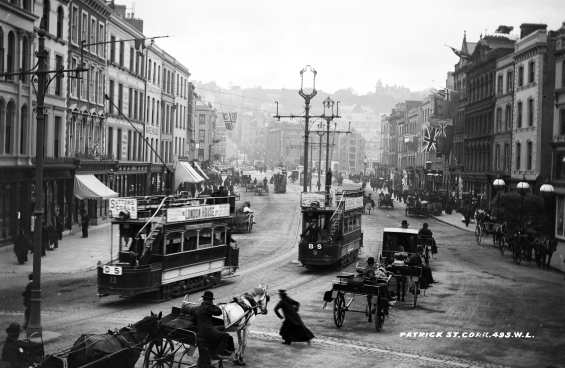“I, Charles Meaney, am a native of Cork city. I joined the Fianna in Cork prior to the Rising of 1916, but when about 15 Fianna lads left the city for Macroom with the Volunteers on Easter Sunday 1916, I was not allowed to go with them as I was considered to be too young. After 1916, we kept together and, later that year, so far as I can remember, the Fianna was divided into two companies, or Sluaghs, as they were known, one for the portion of the city north of the River Lee, and, one for the districts south of the river. We had about 60 lads in the organization at that time, but their number increased subsequently to about 100 on the rolls.
During 1917 and 1918, our activities consisted of drilling, general training of a military nature, lectures in first aid and rifle shooting. A .22 rifle was used in the lectures on the rifle. We were also taught how to use a revolver of which we had just a few.
Our headquarters varied from time to time. We met in ‘An Grianan’, Queen St., Cork; a room in South Main St., Cork; in Drummey’s premises, Pope’s Quay, and in McGurk’s in North Main Street.
During the general election of December 1918, we were very active in distributing election literature for Sinn Fein, posting bills (sometimes at night during curfew) and generally helping out in the intensive propaganda efforts by Sinn Féin which were a feature of that particular election.
We wore a uniform consisting of a blue short pants, green shirt, saffron scarf and green slouch hat. Fianna officers wore Sam Browne belts. When engaged on route marches we always wore this uniform, notwithstanding the ban placed on the wearing of military uniforms by the British, sometime in 1918, so far as I can remember.
It was, to the best of my recollection, early in the year 1919 when, due to increasing numbers, it was decided to form three Sluaghs in Cork city. These were known as the North Sluagh, Centre Sluagh and South Sluagh. There would be on an average of from 30 to 40 boys in each Sluagh. This was what might be called the ‘paper’ strength of the Fianna. Quite a number of the boys, because of their youth, would not be called on for any hazardous tasks,
As a matter of fact, as the struggle developed in the years 1920-21, the really active members, of the Fianna in Cork could be said to number not more than 30; not all of these were armed; indeed, it would be safe to say that there were not more than a dozen revolvers in the Fianna during the hottest period of the fight, i.e., 1920-1921.
Generally speaking, the major activities during this period might be summarised as follows: raids on private houses for arms; scout duty for the I.R.A.; destruction of enemy stores; enforcement of Belfast boycott; dispatch carrying; and attacks on individual enemy personnel.
These attacks on individual members of the enemy forces were a [common] feature of Fianna activities 1920-21. Three or four of us waylaid soldiers and Black and Tans who were sometimes in the company of girls, or, perhaps, leaving a public house in a drunken condition. Whenever the opportunity offered, we attacked them, took their equipment and, in quite a good few instances, got revolvers as well.
In Maylor St. one night, E. Keating, a Fianna boy, alone and unarmed, attacked and disarmed a Black and Tan. The same lad with another Fianna boy named Tommy Creamer disarmed a Tan outside the Courthouse one evening. On another occasion, in company with Frankie Nolan and a few others, we met up with a group of soldiers off duty in the city. We ‘waded’ into them, beat them up and took their bandoliers. They were unarmed. Leaving the scene of the fight in which we were greatly outnumbered, we met a Volunteer named Mick Kenny who advised us to stand in a doorway and fire back at the military who were following us up. Nolan and I were armed with revolvers. We took cover and, as the soldiers approached, opened fire. They beat a hasty retreat.”
– Charles Meaney, Captain ‘H’ Coy, Fianna Cork City (Bureau of Military History Witness Statement)

One thought on “‘Fianna Eireann in Cork City’ by Charles Meaney”